|

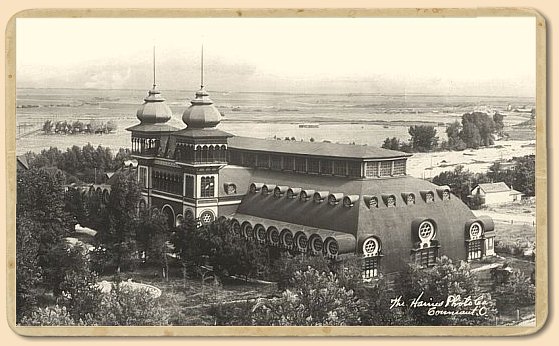
The spectacular natatorium was designed
by the German-born Helena architect
John C. Paulsen, and his partner Noah J. McConnell.
View
looking northeast, ca. 1908
LIBRARY
OF CONGRESS
| The
natatorium was the most important example of Moorish architecture
in the Northwest. It housed the largest indoor "plunge"
in the world. A rectangular nave covered the 300' x 100'
pool. The
hot-spring water for the complex was delivered via redwood
pipes from the source 1.5 miles to the west. Over one million
gallons per day of hot and cold mountain spring water flowed
through the system. The pool had
a maximum depth of 12'. |
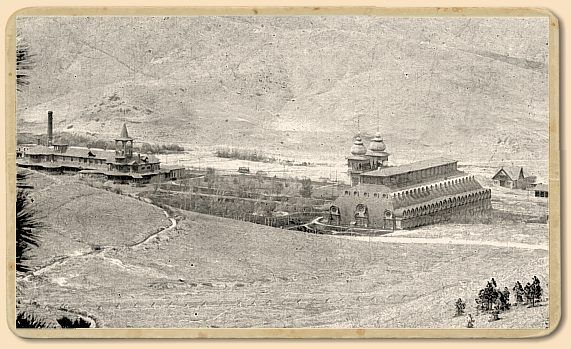
|
An
unusual early view, showing the eastern side of the natatorium.
Beneath
the lower circular windows was a long row of dressing
rooms. On the hillside in the foreground, note the upper
(1865) and lower (1873) "Yaw Yaw" ditches, carrying
water from Ten Mile Creek to Helena.
|
DETAILED
VIEW
PRIVATE COLLECTION
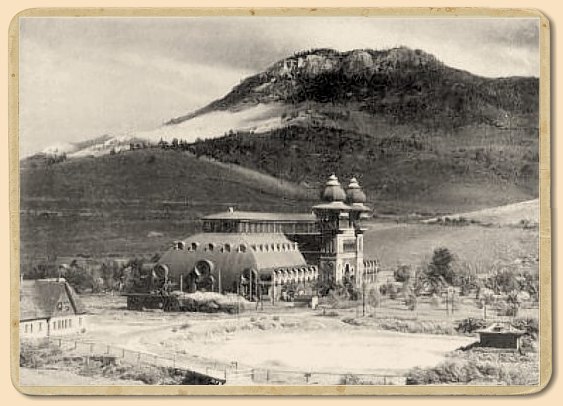
Natatorium
and Mount Helena, looking southeast.
|
MYSTERIOUS
DEATH AND BURIAL OF THE ARCHITECT
|
|
The
architect of the natatorium, John C. Paulsen, had a history
of political corruption relating to the construction
of public projects. In 1896, seven years after completion
of the Broadwater project, he became embroiled -- as State
Architect -- in a major kickback scandal involving construction
of the Montana
Capitol Building.
On March
31 1897, just hours before he was
to testify before a Grand Jury, Paulsen's wife found
him dead in the bathroom of his Kenwood home. The coroner's
official finding was that Paulsen died of a stroke
("cerebral apoplexy"), but other persistent
reports claimed he died from a gunshot to the head, perhaps
self-inflicted -- perhaps not.
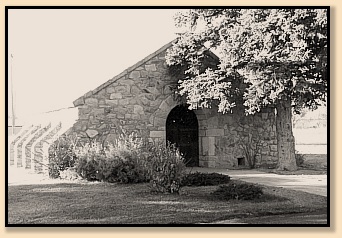
RECEIVING VAULT - FORESTVALE CEMETERY
PHOTO BY RIC SEABROOK, COURTESY OF CHARLEEN SPALDING
Because
the ground was frozen and burial impossible, his body
was placed in the Receiving Vault at Helena's Forestvale
Cemetery to await the thaw; but the suspicious circumstances
surrounding his death - and claims that he had been sighted
alive and well - necessitated an identification of his
body shortly after his death, mainly for insurance purposes.
Records
of the Herrmann & Co. Funeral Home in Helena state
that on May 6 1897, they dispatched a driver and wagon
to Forestvale to carry Paulsen's zinc-lined coffin to
the railroad depot for transport to an unnamed location.
There, John C. Paulsen slipped from history; there is
no record known of the final dispostion of his remains.
Reports
that Paulsen committed suicide continued into the
20th Century; the newspaper clipping below is from the
March 30, 1902 Atlanta Constitution...
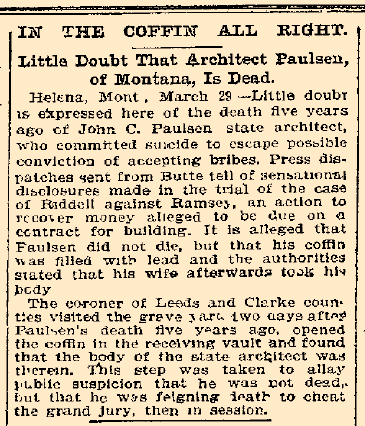
Will
we ever know the real story? It's
doubtful. When corrupt politicians and large sums of money
are involved, the truth is naturally scarce -- and people
are quite expendable.
•
MANY THANKS TO HELENA HISTORIAN CHARLEEN SPALDING FOR
HER HELP WITH THIS SECTION •
|
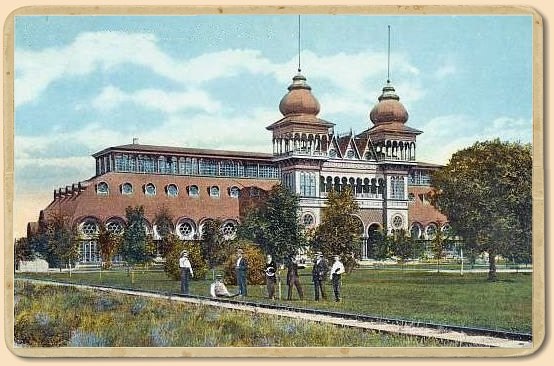
Natatorium
from the NW. Patrons
waiting for the trolley.
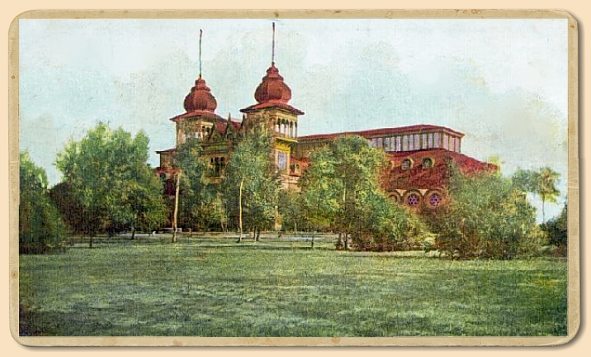
Natatorium from the SW.
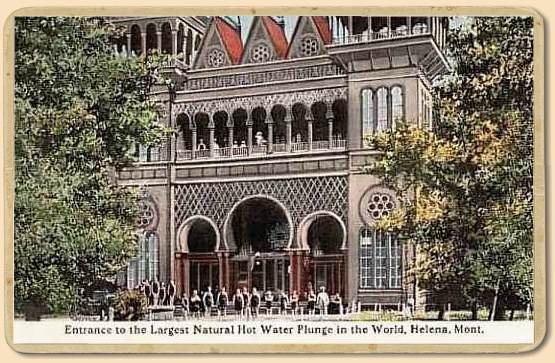

| At
the southern end of the pool, there arose a 40' high waterfall
made
of huge granite boulders. It stood alone and open to the
elements for decades after the plunge was demolished. |
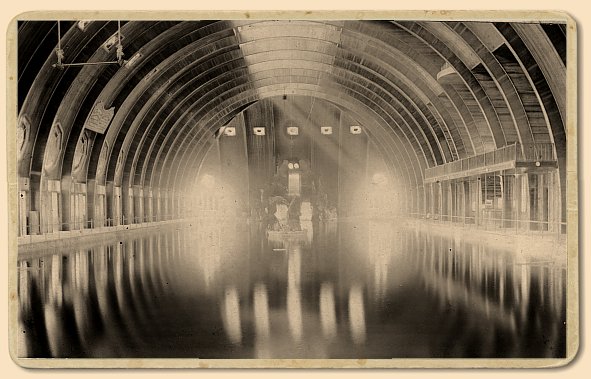
An
early interior view by photographer Arthur Canning.
COURTESY
OF SCOTT NELSON - THE
BRIDGEWORKS CONSERVANCY
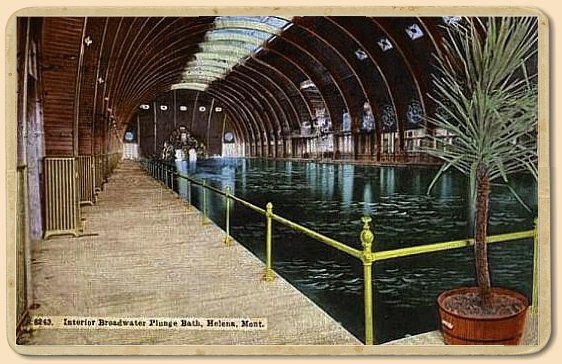
|
There
were "toboggan planks", springboards, and an
observation gallery.
Stained-glass windows and clestories ringed the pool,
and rows of high windows admitted light to the interior.
Colorful tiles covered the floors and walls. There were
100 steam-heated dressing rooms. When the electrically-lit
natatorium was viewed from outside at night, it was said
to glitter like a box of jewels.
|
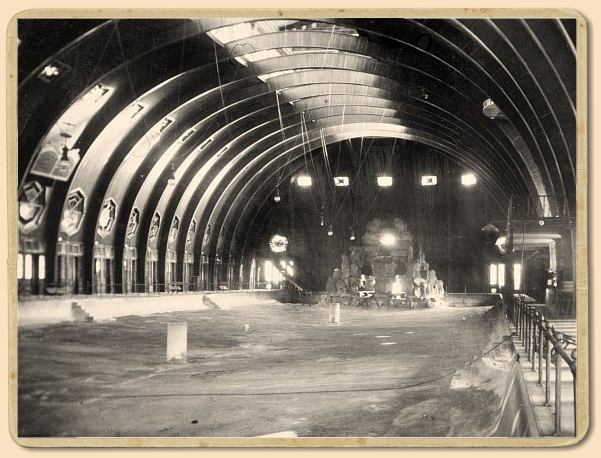

COURTESY
OF SCOTT NELSON - THE
BRIDGEWORKS CONSERVANCY
|
Natatorium
interior, 1940. Note the roof trusses which were
added to stabilize the structure after the 1935
earthquakes. Although unattractive, the trusses
did their job. The insurmountable problem caused by
the earthquakes was the collapse of the thermal vent
which provided hot spring water for the pool. Attempts
were made to keep the pool filled by transferring hot
water from the hotel boilers. Then, they simply tried
to get by with using less water, as sen in the photo
above. But it was all to no avail, and the natatorium
was finally closed.
The Broadwater acreage was
purchased by Norman Rogers in November of 1945.
He announced plans to renovate and reopen the resort,
but this was never done. In July of 1946, Rogers threaded
thick steel cables through the windows of the natatorium,
hooked them to a bulldozer, and began pulling down the
historic structure. "She's still stubborn",
Rogers was quoted as saying as the great building shuddered.
There were rumors that the timbers and cedar paneling
were then sold for firewood.
As
late as 1948, Rogers claimed he intended to renovate
and reopen the resort, but what was left of it continued
to decay. For decades, the stones of the waterfall stood
as the only visible reminder of the opulent plunge.
Now they too are gone.
|
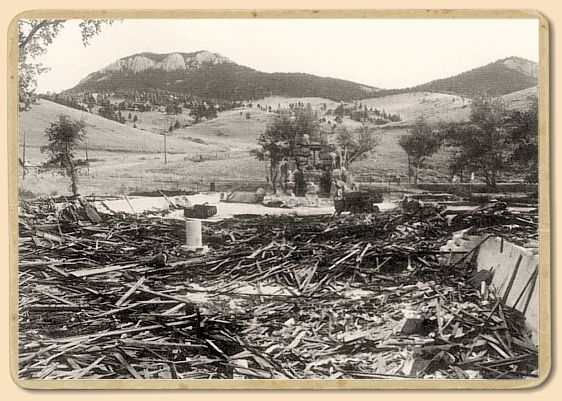
Demolition
of the natatorium, 1946.
MONTANA
HISTORICAL SOCIETY
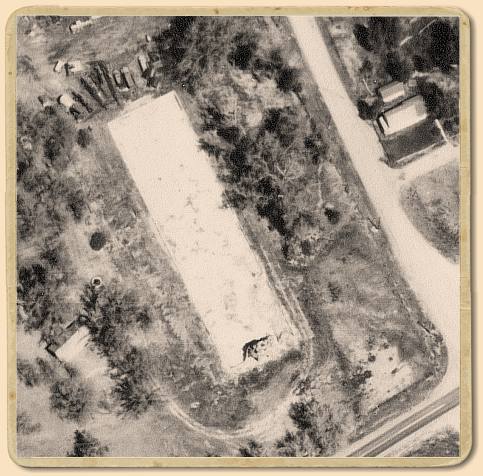
Aerial
view of the open pool, 1953.
COURTESY
OF SCOTT NELSON - THE
BRIDGEWORKS CONSERVANCY
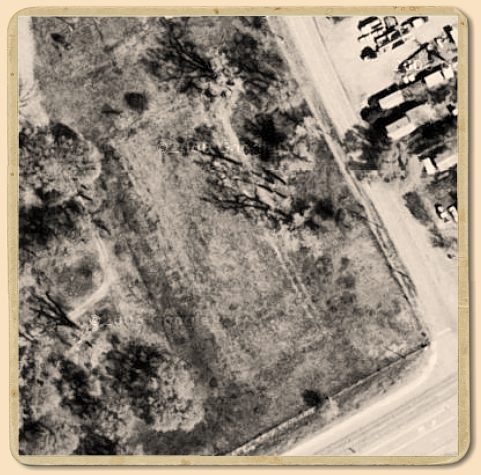
Recent
satellite view of the Natatorium site.


|